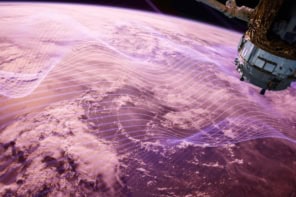
Glaciers along the margins of Antarctica and Greenland are flowing into the ocean at an ever-increasing rate due to rising sea temperatures, warn researchers in the UK.
The “dynamic thinning” of these high-latitude ice sheets has been tracked over a five-year period using lasers on board a NASA satellite and detailed in a new series of topological maps. The unprecedented resolution of the data could help physicists to develop more accurate models of the poorly understood processes involved in glacial melting.
Glaciers are like “rivers of ice” that drain water from the mountains to lower levels. Where the ice meets the sea it either melts, breaks away into the ocean as icebergs, or feeds into the ice shelf – a floating extension of the land. Under stable environmental conditions there exists a balance in which ice lost to the sea as melt is continually replaced by the falling of snow inland. However, a sudden rise in sea temperatures can cause this balance to be disturbed – the result being that coastal ice-melt is not sufficiently replaced by inland precipitation.
“We don’t really have sea-level rise projections, because we don’t understand these processes,” Richard Alley, Penn State University
Scientists estimate that melting land ice is contributing 1.8 mm of the current 3.2 mm annual sea rise. In the latest report of the Intergovernmental Panel on Climate Change (IPCC) there is a worst-case scenario in which a 4 °C rise by 2090–2099 will result in an average sea-level rise of 0.26–0.59 m within the same period. The forecasted rise comes from a combination of melting ice sheets and the thermal expansion of sea waters.
Disturbing the natural balance
As the IPCC admit, however, their figures do not consider the potential of a runaway contribution from glaciers. Increasing melt along the lower part of the glacier can serve to lubricate the flow of ice into the sea and thus disturb the balance even further. The resultant “dynamic thinning” of glaciers has been tracked by using GPS and radar, but previous sensors have struggled to build a full extent of what is going on as it is difficult to resolve the faster-flowing coastal glaciers.
In this latest research, Hamish Pritchard of the British Antarctic Survey and his colleagues have now mapped the entire margins of the Greenland and Antarctic ice sheets. They achieved this in unprecedented detail by reflecting signals off the ground using lasers aboard ICESat – a NASA satellite launched in 2002. Reporting their finding in Nature, the researchers find that the dynamic thinning of glaciers now reaches all latitudes in Greenland and has intensified on many Antarctic sites.
By monitoring these regions between 2003 and 2008, the researchers found that, in Greenland, glaciers flowing faster than 100 m/yr thinned at an average rate of 0.84 m/yr; while in the Amundsen Sea embayment of Antarctica thinning was as high as 9 m/yr for some glaciers. They attribute these high speeds to the fact that dynamic thinning now occurs deep in the interior of each ice sheet. “We were surprised to see such a strong pattern of thinning glaciers across such large areas of coastline – it’s widespread and in some cases thinning extends hundreds of kilometres inland,” said Pritchard.
Breaking the ice, but a lot of mystery still remains
Pritchard cautioned that it is still too early to suggest the increasing speed of these glaciers will inevitably lead to runaway thinning. “There is still a lot of physics still to be understood,” he said. “One of the big challenges is to try and untangle the varied environmental factors that influence the rate of melting where these glaciers reach the coast.”
There are many researchers who are trying to build improved ice-flow models, and some are already trying to assimilate data from glacial surveys. Richard Alley is a climate modeller at Penn State University in the US. “We don’t really have sea-level rise projections, because we don’t understand these processes,” he said. Alley is positive about the latest research. “These are great data to assimilate, and tune models, and may provide sufficient data to allow both model building and testing”, he said.
Andrew Shepherd, an earth observation researcher at the University of Leeds in the UK agrees that it is important to achieve a better clarity on the processes involved in glacial melting. “The important issue is that we (IPCC) have yet to settle on a way to estimate the future sea-level contribution due to each mechanism, and so the jury is still out.” Shepherd feels, however, that this latest research does not offer a compete picture. “The dataset covers a relatively short period (about 5 years I think) and we know that there is no reason to expect the changes to be linear”.
Pritchard described to physicsworld.com some of the technical problems that the team experienced when gathering the data. One problem was that they could not run the laser measurements continuously. “We had to run it in bursts, which meant our data came out a bit ‘stripy’.” He hopes to avoid this problem when the team continues its research using data from ICESat II and the European Space Agency’s Cryosat, both of which will launch next year.



